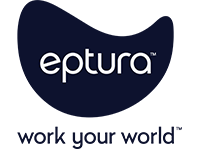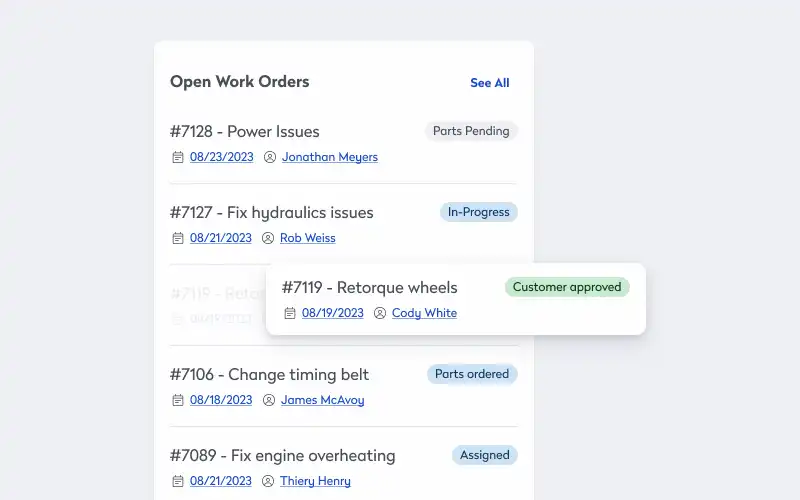
With more people expected back at the office over the next 12 months, enterprise-level companies are facing new operational challenges. In fact, 34% of companies plan to increase in-office days, putting more pressure on workplace and facility managers to strike the balance between enhancing the employee experience and optimizing efficiency, according to Eptura’s 2025 Workplace Index report.
In our April 2025 product announcement, we unveiled updates designed to help organizations meet these challenges through improved technician productivity and automated workplace operations. By laying the right groundwork and establishing a strategic partnership with the right software solution provider, workplace and facility leaders can ensure a successful rollout that positions their organizations to maximize its return on investment.
Include the right stakeholders
Because every organization they work with is different, the provider’s teams will need access to the right data and workflows to ensure everything is set up in the system properly.
Start by considering the key departments and roles that will routinely interact with the new software. This typically includes IT, management, and end-users from various locations and departments. For IT, involve your system administrators, network engineers, and any developers who will be responsible for the technical aspects of the implementation. From management, include project sponsors, department heads, and any executives who will need to approve the project or provide resources. You likely need to include facility and maintenance managers, for example, because they provide critical data about assets, equipment, and schedules. You can also consider including representatives from human resources, finance, and the legal department because they may have specific requirements or issues related to compliance.
An experienced, proactive professional services team will also want “escalation contacts,” which is just a list of the people at your company that manage the stakeholders. For example, the escalation contact for the maintenance lead might be the facility manager. For the workplace manager, it could be the head of HR. The value of the list is that if there’s ever an issue the professional services team can’t resolve with a stakeholder, they know exactly where to go next.
The perfect number of stakeholders for a rollout
A successful plan meets the organization’s specific situation and needs, so there’s no perfect number or combination of stakeholders that work for every rollout. In many cases, industry and company size affect who you can include.
At larger companies, there’s increased specialization, with roles and responsibilities divided among more people, so collecting the right data and workflow insights means working with a bigger group. At smaller companies, though, the main stakeholder is someone from the IT team. They’re the one who will administer the software and ensure it’s properly connected to the rest of the organization’s IT stack.
There are also differences across industries. In some, end-users are more involved, while in others, they’re not. For example, rollouts at fleet-based companies typically don’t include the drivers as stakeholders, even though they might be the ones on the software most. At a manufacturing plant, though, the teams that run and maintain the assets and equipment on the production line are closely involved in most stages of the rollout.
Create a definition of success
There are standard sets of industry best practices and related key performance indicators (KPIs) for workplace and asset management. Facility managers look at, for example, preventive maintenance inspections and tasks completed on time, uptime, and maintenance costs. Workplace leaders focus on overhead costs and utilization numbers. But many companies also have specific goals related to past performance and current challenges. A maintenance manager seeing a lot of inconsistencies in inspections and tasks might be more interested in finding reliable ways to capture and share tribal knowledge. A workplace leader who finds themselves fielding constant complaints about the office layout would want more space planning tools.
The more concretely you can articulate your goals, the better your software provider’s professional services team can set up the software to help you reach them. If there is something you want to track, it’s important to make that clear during the implementation process.
Some companies come into the process already knowing exactly what they want and need. Organizations implement software to address specific challenges, so they likely know exactly what data they want to capture so they can track improvement. It’s often the case, though, the companies don’t have a clear definition of success. In those cases, it’s important for them to work with the professional services team to create a shared vision.
The process can start with asking a key question: “At the end of the day, when you log in, what do you want it to tell you?”
Eptura’s reports and dashboards
At the product announcement event in April, e introduced several new ways to track and report on data, including
- People and Places KPI Dashboard: Combines reservation and lease data to help real estate leaders assess space utilization and refine hybrid work strategies, providing insights into occupancy rates, booking trends, and space efficiency, which enables better decision-making
- Enterprise Overview Dashboard: Aggregates asset, booking, and visitor data to create a single source of truth for performance management, offering a comprehensive view of resource usage across the organization, which helps leaders monitor and optimize operations
- Global Admin Dashboard for Visitor Management: Simplifies oversight across multiple locations with region-specific settings and audit controls, allowing administrators to manage visitor policies, track visitor activity, and ensure compliance with security protocols, which makes it easier to maintain consistent and secure visitor management practices
They’re examples of how having established goals and KPIs—a definition of success — helps when implementing new solutions. If companies know what they want to track and improve, the professional services team can help them properly populate these highly configurable dashboards, so leadership gets the numbers they need in the formats that work best for their workflows and reporting requirements.
Consider running a pilot program
For enterprise-level organizations with multiple locations, initiating a pilot program at one facility can offer several advantages. One of the primary benefits is the opportunity to thoroughly test the software’s functionality in a real-world environment, allowing you to identify and address any technical issues before a full-scale rollout. By gathering feedback from a smaller, more manageable group, you can make necessary adjustments and improvements, ensuring a smoother and more efficient deployment across the entire organization.
Starting the pilot program at the company headquarters provides a chance to build additional buy-in from the C-suite and other key leadership figures. When top executives see the direct benefits of the new system, such as improved efficiency, enhanced productivity, and better reporting, they are much more likely to support and advocate for enterprise-wide implementation. An early endorsement from leadership can help secure the necessary resources and funding, as well as foster a positive attitude and enthusiasm among employees.
The differences between a pilot program and a phased rollout
The benefits of a pilot program come from your ability to apply lessons learned to subsequent locations. So, if during the first rollout you discovered the maintenance department needed a specific type of tracking or reporting for inventory, you could preemptively set it up when rolling out at future locations. That means pilot programs work best when the locations have similar budgeting processes, compliance requirements, and governance structures. You can’t apply insights from a workflow from one facility unless it also exists at other locations.
It’s important to understand how pilot programs are different from phased rollouts.
A pilot program is a small-scale, initial test of the software in a controlled environment. It typically involves a single location or a small group of users within the organization. The primary goal is to evaluate the software’s functionality, performance, and user acceptance. You can gather detailed feedback, identify any issues, and make the necessary adjustments. The approach helps mitigate risks and ensures that the software meets the organization’s needs before committing to a full-scale deployment.
A phased rollout, on the other hand, is a more structured and gradual approach to deploying the software across the entire organization. Each phase may have its own set of objectives and timelines, allowing the organization to manage the transition more effectively. Phased rollouts help spread out the workload, reducing the impact on daily operations, and providing ongoing opportunities for feedback and refinement. It can be particularly useful for large, complex organizations where a sudden, full-scale deployment could lead to significant disruptions and challenges. By breaking the rollout into manageable steps, you can ensure a smoother and more controlled transition, ultimately leading to a more successful and sustainable implementation.
Provide prompt support and role-specific training
Two critical KPIs for software implementation are user adoption rate and user engagement rate, so it’s important to invest in ongoing training and support to help users gain proficiency. Address concerns and questions promptly to build confidence and reduce resistance.
Also ensure that training and support are tailored to the different roles and responsibilities within each location. When developing training programs for different roles, ask yourself, “What does someone in this role need to accomplish?” and “What data and workflows do they need to do that?” Based on the answers, you can start to make informed decisions about the training they require.
Eptura’s mobile apps for technicians
Eptura’s mobile app for maintenance technicians featured in the product announcement event is an example of how training should match the end-user’s workflows. By creating clear communication channels and access to critical data in the field — both with and without Wi-Fi or cell service — the app improves technician efficiency while ensuring the department has the data it needs for actionable insights.
Technicians can instantly access and update assigned work orders, asset data like location and repair and maintenance histories, and associated parts and materials. With real-time data input even outside of Wi-Fi and cell service, they don’t have to rely on memory, which means more reliable data capture. In fact, the app has voice-enabled assistance that supports hands-free data entry, so they don’t even need to type.
The work they do ties directly to many other critical workflows. For example, all the work orders the technicians access and update through the app are also reviewed, approved, prioritized, assigned, and tracked by the maintenance lead to allocate resources and track KPIs. The work order data also updates parts and materials levels, which the maintenance and procurement teams can use to control inventory. Regardless of how many other workflows data from the app supports and improves, though, technicians only need to know how to use the app.
Success starts with the right software provider
Selecting and rolling out the right workplace and asset management software solution is a multistep, cross-functional process that can involve departments from across the organization. This comprehensive journey includes needs analyses, applications for funding, requests for proposals, demonstrations, and thorough vetting. Picking the right platform means more than just checking off a list of desired features. It also involves finding a provider that can become a true partner, ensuring the rollout is smooth and successful.
When comparing providers, you should ask specific questions about implementation to gauge their capabilities and commitment, including:
- What is your implementation process?
- What are the typical timelines for implementation?
- Have you implemented software for other companies in our industry?
- What are the qualifications and experience levels of your implementation team?
A well-defined process can help you anticipate what to expect and ensure that all necessary steps are covered, from initial setup to final deployment, while knowing the expected duration of the implementation can help you plan your resources and timelines effectively. Factors such as the complexity of your requirements and the size of your organization can influence these timelines, so it’s important to get a clear estimate.
Providers who have worked with similar companies can offer valuable insights and best practices, helping to mitigate risks and ensure a more tailored solution. Also make sure to inquire about the team’s average tenure, seniority levels, and specific certifications or industry expertise. A team with a strong background and relevant experience can provide better support and more effective solutions.
In the end, the foundation of a successful implementation is your partnership with your provider. A provider that acts as a strategic partner will not only deliver the software but also guide you through the entire process, offering support, expertise, and a commitment to your long-term success. They should be able to adapt to your unique needs, communicate effectively, and provide ongoing assistance to ensure that the software integrates seamlessly into your operations and meets your organizational goals.






